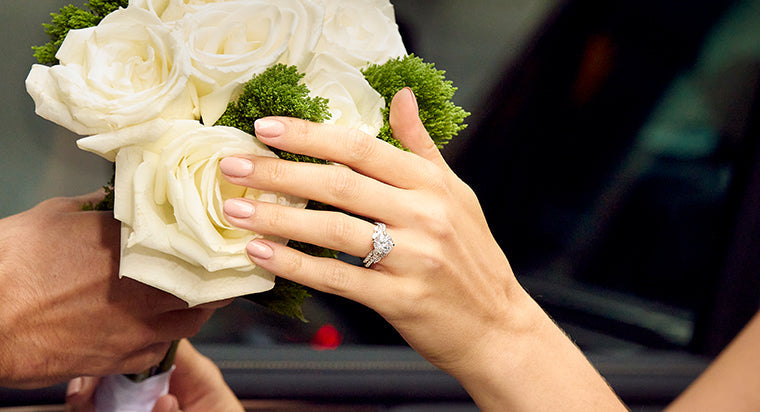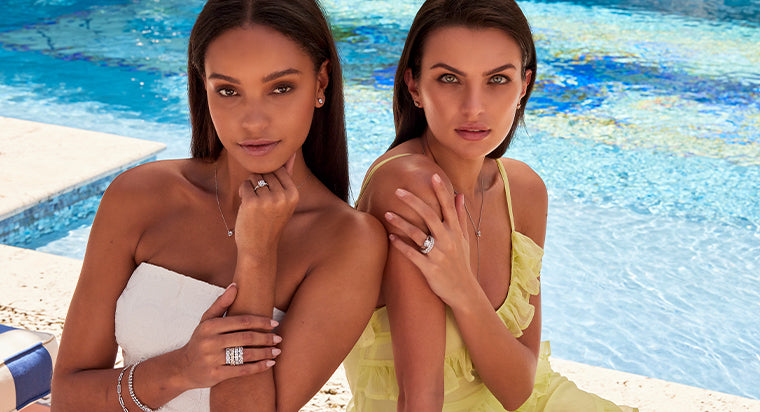A Guide to Stacked Wedding Bands

If we can say one thing about weddings, it's that they are steeped in tradition. Each culture has its own traditions, and in most countries, some form of wedding ring is worn. From here, though, we would argue that jewelry traditions are meant to be broken. In particular, there's no reason why a bride MUST wear a plain wedding band and simple solitaire ring. These days stacked wedding bands are more popular than ever. Let's look at this option in depth.
TABLE OF CONTENTS
Stacked Wedding Bands?
Most of us know what a traditional ring set is: an engagement ring and a matching wedding band. These wedding band sets are made to look nice together and to be worn together. A ring stack is something slightly different: a group of three or more rings that are worn together on the same finger.
However, from here there are many options. As a general rule, stacked wedding bands should be a group of rings that is easy and comfortable to wear together. After all, while you can mix and match from the stack, it is assumed that you will wear these rings every day. For this reason, you should always consider the maximum metal thickness that you can wear comfortably. It’s relatively easy to do this by putting a bunch of your own rings on a single finger, then seeing how they feel.
How to Design Your “Ring Stack”
Within the limits of what is comfortable for you to wear, there is a lot of freedom when it comes to design. For instance, you can go for mismatched stacked wedding bands, so long as the whole stack will look nice together. With that in mind, here are some design tips.
Mixed Metals? Go for it!
In the last few decades, most wedding band sets have been in one color of the metal. Most common, of course, was white gold in any level of purity. However, yellow gold is classic, and rose gold can add a vintage or romantic vibe. Finally, platinum is a common setting for high-end engagement rings.
Especially with stacked diamond wedding bands, it's easier to mix metal colors than you'd think. The diamonds provide a unified look between the bands, regardless of metal color. So, you might consider a thin rose gold band with small diamonds and a white gold diamond solitaire. Especially if you use the same diamond shape or shapes that go well together, this can look really nice.
Stack it up…How High?
Another consideration is how many rings you should include among your stacked engagement rings and wedding bands. As a general rule, an odd number of rings looks best. This means that you might start with one additional ring besides your engagement ring and wedding band. An easy way to do this is to get an engagement ring with a high setting. Then, add a wedding ring that contours around the ring, and a third one when the first child is born.
Of course, you don't have to stop with three. Rather, you can add stacked anniversary bands over time. One great way to do this would be to get a new ring every few anniversaries or combine these with “new child” rings. The possibilities are only limited by the space on your finger, and your imagination. Keep in mind, the rings can be very narrow if you want. Plus, you can wear fewer rings on some days than others.
Colored Stones, Too
Your stacked wedding bands with solitaire rings don't have to be strictly in white diamonds, though. In fact, there are lots of great looks using gemstones mixed in with diamonds. One way you can do this is by including the appropriate birthstone with each ring celebrating a new child. Over time, the stack could get very colorful. Alternatively, you might use your own birthstone or something with sentimental value.
With colored stones, the metal color becomes more important. Most design experts recommend that if you mix stone colors then the metal color should always be the same. In other words, mix metal colors OR stone colors, not both. Mixing both can threaten the harmony of your mismatched stacked wedding bands.
Here's the most important point: almost all ring stacks are custom to some degree. Ring “sets” that include an engagement ring are typically no more than three rings: one band on each side of the “big” diamond. However, they can usually be purchased separately, potentially allowing for mixed metal selections. For a fully custom look, though, With Clarity offers custom design and manufacturing. Our gemologists will be happy to help.

Ring Care
Finally, let's look at a bit of ring care. When you aren't wearing your rings, you need to store them carefully to protect them from scratching and other damage. This means using a fabric pouch, ring box, or other methods of keeping them away from direct contact with other jewelry. In addition, you should keep your rings away from harsh chemicals and abrasives. If dirt builds up, use a jewelry cleaner or soap and water along with a toothbrush to remove it.
Unfortunately, poor storage and harsh chemicals aren't the only threats to your rings. Regular wear and tear, as well as a few hard knocks, can damage metal or stones alike. You should let a jeweler examine your rings regularly for broken prongs and other damage. This way, you can avoid losing stones or needing expensive repairs.









